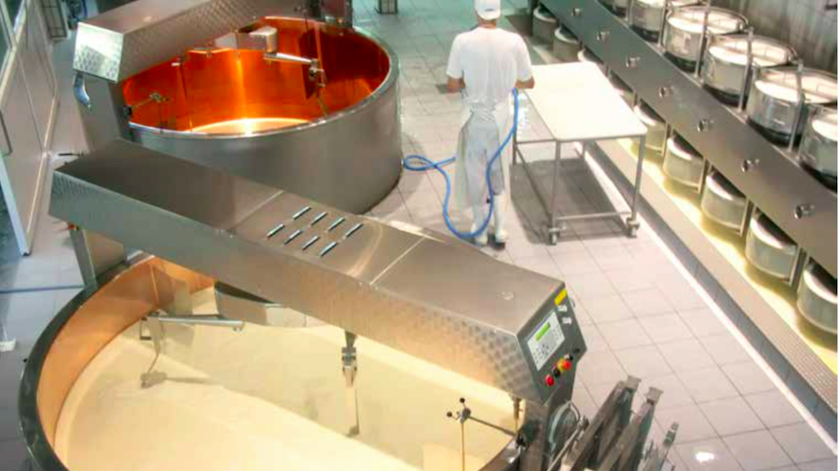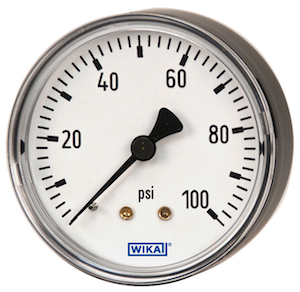
Pressure gauge readings come in a variety of international units. In most of North America, psi (pounds per square inch) is the standard unit of pressure measurement. Industrial processes and scientific laboratories rely on gauges reading in psi to measure relative pressure (psi or psig), absolute pressure (psia), and differential pressure (psid).
Gauges readings in psi come in a variety of models and can be applied to all industrial and process applications. The majority of gauges reading in psi are sold and used in the U.S. and Canada. Most other regions around the globe use gauges reading in metric units such as bar, kPa, MPa, and kg/cm2, to just name a few.
Types of Pressure Gauges
Industrial gauges come in both analog and digital versions. Analog pressure gauges use a Bourdon tube, diaphragm element, capsule element, or magnetic piston for sensing pressure. Digital pressure gaugesrely on thin-film technology or a diaphragm.
There are three main types of industrial gauges:
Standard pressure gauge

Model 111.12 Bourdon tube pressure gauge with gauge reading in psi
The Bourdon tube is the most common sensing element for gauges that measure gauge pressure relative to atmospheric pressure. The smallest pressure range for Bourdon tubes is 10 psi (0.6 bar). For very low pressure ranges (< 10 psi or 0.6 bar) and for gaseous media, the capsule or bellows sensing element is commonly used. Also for low pressure ranges, but for liquids and aggressive media as well, a diaphragm element is the better choice.
In most cases, a standard pressure gauge is reading the total pressure minus the atmospheric pressure. In other words, a pressure gauge reading relative pressure is always exposed to atmospheric pressure and reads zero at atmospheric pressure. This pressure can be either positive or negative (vacuum), depending on the pressure as it relates to atmospheric pressure.
The unit for a pressure gauge reading relative pressure is psi (pounds per square inch) or psig (pounds per square inch gauge). “Gauge pressure” is another way of saying “relative pressure,” and most manufacturers use the term “psi” rather than “psig.” WIKA USA offers a complete line of standard gauges reading in psi, with a wide variety of models designed to meet the needs of many industries and applications.
Absolute pressure gauge
An absolute pressure gauge operates with the same technology as standard pressure gauges. The difference is that zero is referenced against a perfect vacuum, which is constant, instead of the ambient atmosphere, which changes depending on weather conditions and altitude. Absolute pressure gauge readings are used in applications that require non-variable values, and those instruments include altimeters and barometers.
In food processing applications, absolute pressure gauges are used to monitor the performance of high-end vacuum pumps to ensure that perishable items are sufficiently sealed. The unit of a pressure gauge reading absolute pressure is psia(pounds per square inch absolute). WIKA offers several models of absolute pressure gauges for industrial and scientific use.
Differential pressure gauge
A differential pressure gauge measures and calculates the difference between two applied pressures. Differential pressure can be used to measure:
- The pressure drop across an orifice
- The level of liquid gases in sealed vessels
- The pressure drop across a filter
For example, by monitoring pressure on both sides of an air filter or water filter, operators can detect whether the filter is dirty (when the differential pressure reaches a critical threshold) and needs to be replaced. Because of their high quality and robust design, tens of thousands of WIKA differential pressure gauges are found today in refineries, processing plants, and medical facilities around the globe.
WIKA USA is one of the world’s largest manufacturers of industrial pressure instruments, and customers trust our reliable and cost-effective pressure products to get the job done. Contact our pressure specialists for expert advice on industrial psi pressure gauges and to determine which measuring device is right for your application.


Am interested in finding the exact readings on a pressure gauge in accordance to particular gases but I can’t find them anywhere,could u please help me out.
Dear Emmanuel,
Thank you for your interest in our blog. However, I am not 100% sure I fully understand your question. The pressure gauge basically reads the pressure of the gas in the pressure line, generated by a compressor, pump etc. I am not sure what you mean by “readings in accordance with particular gases”. Sorry that I couldn’t give you a better answer.